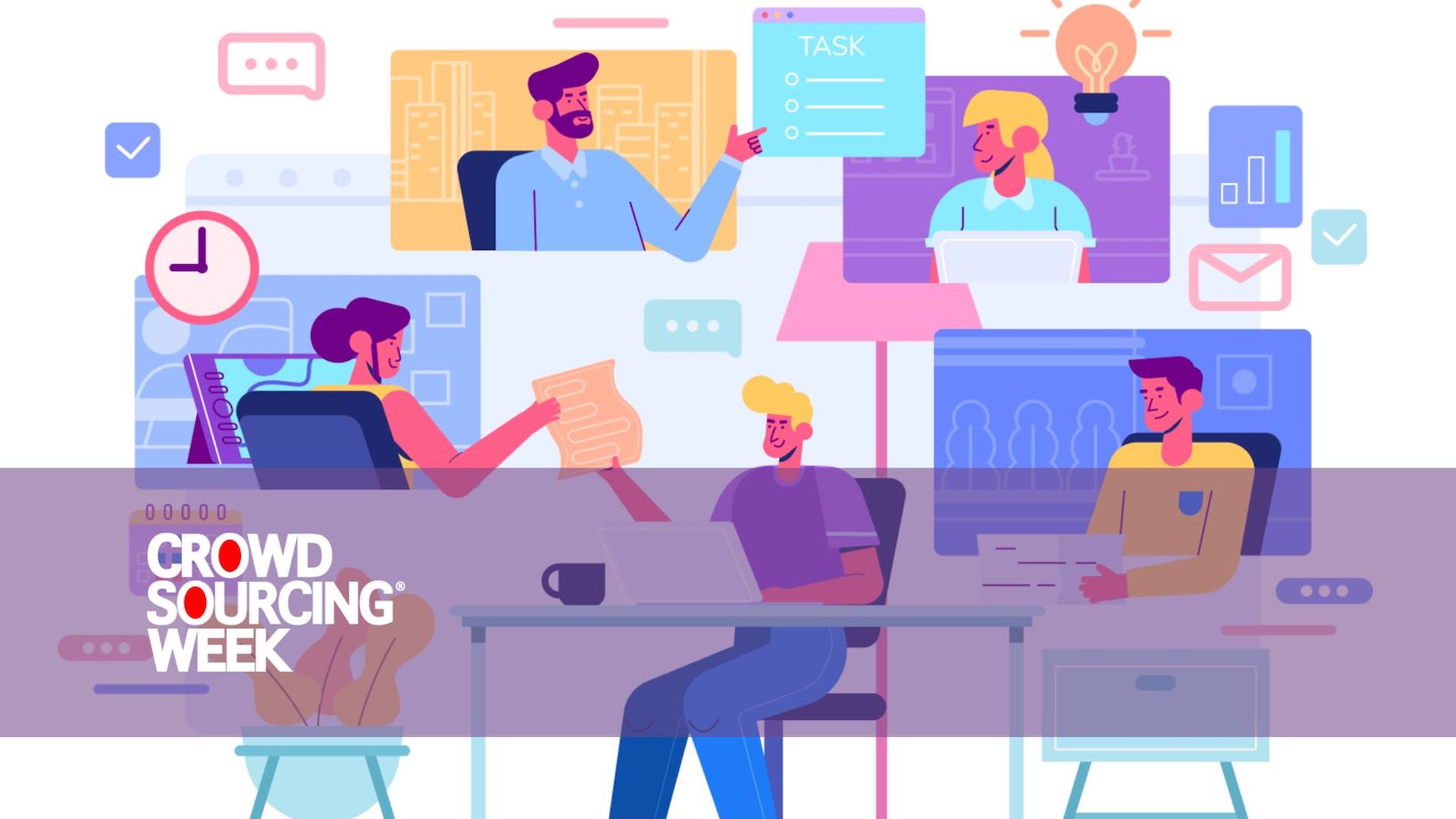The phrase “connected work” refers to a work environment or system where employees, tools, processes, and technologies are seamlessly integrated to enhance collaboration, communication, and efficiency. It involves creating a networked workplace where various elements are interconnected, enabling smoother workflows and more dynamic interactions. This Crowdsourcing Week blog takes a look at the benefits of connected work, the accompanying challenges, some key connected worker platforms, and a look at how connected work will influence the ways businesses operate in the future.
Key benefits of connected work
Use of integrated communication tools such as Slack, Microsoft Teams, or Zoom facilitate real-time messaging, video conferencing, and collaborative document editing. Coupled with adoption of cloud computing to ensure that data and applications are accessible from anywhere, it allows for easier remote work and real-time collaboration.
Project management platforms like Asana, Trello, or Monday.com allow teams to track progress, assign tasks, and manage projects collaboratively. Tools like Google Workspace or Microsoft 365 enable multiple users to work on documents simultaneously, share files easily, and maintain version control. Alongside adoption of flexible schedules, hybrid work models, other digital tools can be used to maintain productivity and connectivity.
Connecting and integrating different software applications through APIs to enable seamless data flow and interoperability between systems. Implementing dashboards that consolidate data from various sources provides a comprehensive view of projects, performance metrics, and other key indicators. Leveraging analytics and business intelligence tools in to the mix can help people make better informed data-driven decisions based on real-time insights.
Externally, AI-driven tools can automate routine tasks, provide quick information, and support better customer service.
Key challenges of connected work

Photo by Joseph Frank on Unsplash
Some care should be taken as to how these tools and connected worker platforms are used so that it doesn’t appear to people they are set tasks and made answerable to faceless automated systems. It requires different management techniques within an “Always On” culture of constant connectivity that may blur the lines between work and personal life, leading to burnout if not carefully managed. Internal social networks, such as Yammer or Workplace by Facebook, foster better communication and engagement among employees, and can help to establish a positive company culture and norms.
An over-reliance on technology can also lead to issues if systems fail or are not accessible.
Additionally, whilst a range of tools support working from any location, including VPNs, secure remote access and mobile device management, there is an increased need for stronger cybersecurity processes to protect data, including encryption, multi-factor authentication, and regular security audits. Employees will require more frequent training on cybersecurity best practices to ensure safe and responsible use of digital tools and resources.
Connected worker platforms
Planview, Brightidea, and similar companies play significant roles in providing tools for connected work, particularly in the areas of project management, portfolio management, and innovation management. Here’s an overview of these companies and what they offer
Planview
Planview offers a comprehensive suite of solutions for project management, portfolio management, and enterprise architecture. Their tools help organisations manage resources, projects, and strategic initiatives. It has over 4,500 customers globally, including 59 of the Fortune 100, and its headquarters are in Austin, Texas.
Their key products are:
- Planview Enterprise One: A strategic portfolio management tool that helps organisations align their projects and resources with business goals.
- Planview PPM Pro: A project portfolio management tool designed for managing project portfolios, tracking progress, and optimising resource allocation.
- Planview LeanKit: A Kanban-based tool that supports agile project management, allowing teams to visualise and manage their work in real-time.
- Planview Spigit: An innovation management platform that enables organisations to crowdsource ideas, manage innovation portfolios, and drive business growth.
Brightidea
Brightidea specialises in innovation management software that helps organisations capture, evaluate, and implement innovative ideas from employees, customers, and partners. Their key products include tools for managing the entire innovation process, from idea generation to implementation.
It was founded in 1999 and has offices in San Francisco and New York City. Brightidea has worked with over 300 leading global brands including Accenture, GM, Amazon, Verizon and T-Mobile, John Deere, PwC, AstraZeneca, Takeda, US Bank and many more.
IdeaScale
IdeaScale was founded in 2009 and is one of a number of connected worker platforms based in San Francisco, California. It provides crowdsourcing and innovation management software that enables organisations to collect and manage ideas, collaborate on solutions, drive innovation and then measure and analyse an innovation’s impact.
It works with a broad range of Fortune 500 companies, major government agencies, non-profits, and educational institutions, with a focus on accessibility, scalability, and actionable insights to turn collective knowledge into tangible results.
Miro
Miro is a visual workspace for innovation that enables distributed teams of any size to dream, design, and build the future together. Its mission is to empower client teams to create “the next big thing” by supporting brainstorming, planning, and visual collaboration through digital whiteboards; templates for various use cases like brainstorming, strategy planning, and agile workflows; and integration with other tools like Slack, Microsoft Teams, and Jira.
Miro believes a flexible mix of in-person and remote co-creation works best for all parties, and it is committed to a hub-centric, hybrid working model it calls Miro Together.
It was founded in 2011 and is headquartered in San Francisco, California, with eight further offices in Europe, Asia and Australia.
Aha!
Aha! offers product roadmap and project management software designed to help teams use idea management and crowdsourcing, plan and manage product development, and release new products in the marketplace. It has helped more than a million product builders bring their strategy to life through a suite of tools including Aha! Roadmaps, Aha! Ideas, Aha! Whiteboards, Aha! Knowledge, and Aha! Develop.
It was founded in 2013 and operates remotely with no specific HQ.
InnovationCast
InnovationCast is a collaborative innovation management platform that helps organisations foster a culture of innovation and manage the entire innovation lifecycle. It helps generate stronger ideas, faster, from employees, partners and customers. Then it helps organisations to decide which ideas to invest in, test the most promising ones without breaking the bank, and then take the best ideas to market to create value.
Monitoring and analysis of business environments uncovers trends, technologies, companies and insights which can trigger further innovation.
InnovationCast was founded in 2007 and is based in Lisbon, Portugal. It provides all the building blocks an organisation needs to support its innovation activities.
ClickUp
ClickUp is a versatile project management and productivity platform that provides tools for task management, time tracking, and collaboration. It was founded in 2017 and is based in San Diego, California.
It replaces all individual workplace productivity tools with a single, unified platform that includes AI, project management, document collaboration, whiteboards, spreadsheets, and goals.
The future of connected work
The future of connected work is poised to significantly influence company growth and transformation by driving innovation, enhancing productivity, and fostering a more agile and adaptive organisational culture.
Automation of routine tasks through AI and machine learning will free up employees to focus on higher-value activities, enhancing overall productivity. AI-driven analytics will provide insights that help streamline processes and continue to improve decision-making.
The trend towards remote and hybrid work will persist, supported by robust digital infrastructure and tools that facilitate seamless remote collaboration and access collective intelligence. Advanced collaborative platforms will continue to evolve, offering more intuitive and integrated solutions that enhance team collaboration and project management. Such connected work environments will help break down silos, encouraging cross-functional teams to collaborate more effectively and innovate.
A shift towards a more transparent, inclusive, and collaborative corporate culture will be essential. Companies will prioritise open communication, diversity, and employee engagement. More ideas and innovations will be crowdsourced throughout an entire company, or even beyond, rather than just within specifically-related departments or divisions.

Flexible workspaces allow employees to work from diverse locations and environments that suit their productivity needs. Photo by Shridhar Gupta on Unsplash
Companies will increasingly adopt flexible workspaces and embrace digital nomadism, allowing employees to work from diverse locations and environments that suit their productivity needs. Using connected worker platforms will expand the talent pool available to businesses, and increased flexibility will lead to higher employee satisfaction and retention, attracting top talent globally, and the reducing the costs of disruption associated with staff churn. Diverse teams will bring more varied perspectives, fostering creativity and leading to breakthrough innovations.
Once again, however, there are consequences, particularly over payment procedures and systems. A diverse workforce spread throughout perhaps several countries, with different currencies and tax systems, will require a thoroughly digital accounts payable service, such as that provided by Tipalti.
Connected work will facilitate better collection and analysis of customer data, leading to more tailored products and services and improved customer satisfaction. However, customers are more likely to require credible assurances that their data is adequately protected for them to remain a customer.
Key takeaways
“Connected work” represents a modern approach to the workplace, leveraging technology to create a more integrated, efficient, and collaborative environment. It facilitates better communication, flexibility, and data-driven decision-making, though it also presents challenges that need to be addressed to maximise its benefits. As organisations continue to adapt to digital transformation, connected work is likely to become an increasingly standard aspect of how work is done.
A number of companies provide a range of tools that are critical for creating and maintaining connected work environments. Their connected worker platforms facilitate seamless communication, collaboration, project management and productivity, enabling businesses to operate more efficiently and adapt to the evolving demands of the modern workplace. As the landscape of connected work continues to evolve, these companies are likely to remain at the forefront, continuously innovating to meet the needs of their users.
The future of connected work is integral to the growth and transformation of companies, providing them with the tools to be more productive, innovative, and adaptive. By embracing connected work, businesses can create more flexible and satisfying work environments, drive continuous innovation, and make data-driven decisions that enhance their competitive edge. However, they must also address challenges such as cybersecurity, technological disparities, and maintaining work-life balance to fully realise the benefits of this paradigm shift.





0 Comments